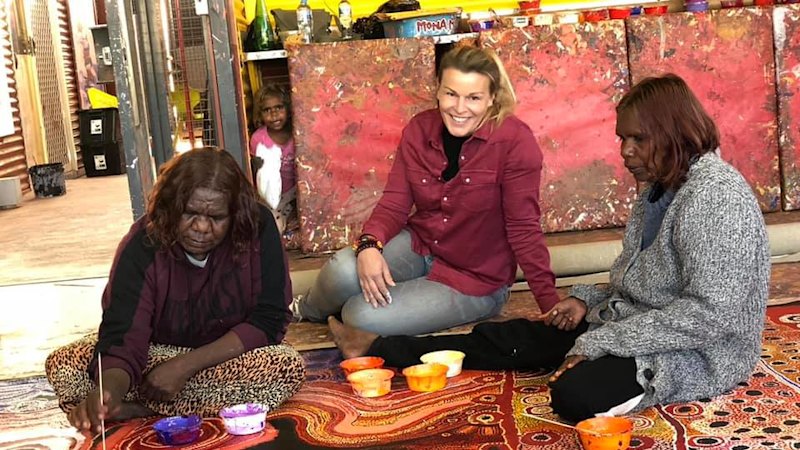
In a remarkable fusion of cultures, Bérengère Primat, a French-born, Swiss-based collector, has transformed a gallery in Lens, Switzerland, into a significant hub for Indigenous Australian art. The Fondation Opale is not only home to one of the largest private collections of contemporary Aboriginal art but also serves as a cultural bridge connecting European audiences with Australia’s First Nations artists.
Located beside a picturesque artificial lake in the Swiss Alps, the recently expanded gallery features artist residencies, a library, and exhibition halls, all dedicated to showcasing Aboriginal art as a living contemporary practice. Primat’s journey began two decades ago when she first encountered the works of artists like Emily Kam Kngwarray and Sally Gabori in a Paris gallery. “It was never a hobby,” she reflects. “It is an obsession.”
Her passion led her to travel extensively across Australia, including areas such as Alice Springs and the remote APY Lands, where she immersed herself in Aboriginal culture and established deep connections with local artists. Over the years, she has amassed around 2,000 works, driven by a desire to honour the stories and experiences that come with each piece.
Primat’s commitment to cultural philanthropy is rooted in her family’s legacy. As the great-granddaughter of Marcel Schlumberger, co-founder of the global oil services firm Schlumberger, and the grandniece of influential art collector Dominique de Ménil, she grew up surrounded by themes of art and science. This background has shaped her vision for Fondation Opale, which aims to present Aboriginal art as a vibrant, evolving practice rather than merely ancient artifacts.
The gallery’s mission crystallised during a pivotal trip to the APY Lands, where an artist lamented the lack of platforms for displaying Aboriginal art in Europe. This comment inspired Primat to ensure that the foundation would serve as a venue for cultural and artistic projects, fulfilling a vital need for Indigenous artists. “The building needed to stay for cultural or artistic projects, and this is how I decided to dive into this,” she explains.
Primat has funded the foundation primarily from her own resources, supported by a network of donors. Under her leadership, the foundation has hosted a series of thoughtfully curated exhibitions that explore various themes, including the intersection of Aboriginal art with other cultural traditions. Current exhibitions, such as Beneath the Reflections of the World, showcase the works of Aboriginal artists alongside international figures like American painter Forrest Bess.
Curatorial guidance comes from Georges Petitjean, who has worked with Primat since the early days of her collection. Petitjean, one of the first scholars to earn a PhD in Indigenous Australian art, has been instrumental in enhancing the credibility and depth of the foundation’s programming. He believes Primat has assembled one of the most significant collections of Aboriginal art in Europe.
Despite her considerable achievements, Primat remains modest about her role in the art world. “Again, I never started the collection for that. That’s not something that is very important for me,” she asserts. What truly matters to her is the impact of the art on viewers, particularly those from Indigenous communities. “One lady told me, ‘I always feel very proud … but when I see what you have done here and how it is presented and exhibited, I feel even prouder.’”
Primat has forged lasting relationships in the communities she collaborates with, an effort facilitated by her willingness to listen and understand. Her children have also embraced this passion, growing up surrounded by Aboriginal art. “All of my siblings – and I’m the oldest of eight children – and my mum, they all have Australian Indigenous art in their house as well,” she shares.
The significance of Primat’s work is echoed by Skye O’Meara, chief executive of the APY Art Centre Collective. She notes that Primat’s efforts have reshaped the landscape for Indigenous artists, prioritising their care and support while fostering ethical pathways in the industry. As galleries become more conservative, Primat’s approach stands out for its focus on living artists and their innovative contributions.
O’Meara emphasizes that the long-term effects of Primat’s vision will become more apparent in the years to come. “We will begin to truly see the historic significance of Bérengère’s vision and the Opale Fondation’s role in elevating Indigenous artists,” she states.
Primat’s dedication has not gone unnoticed, as more global institutions and commercial galleries begin to recognise the value of Indigenous Australian art. Celebrated collectors, including Steve Martin, are also taking the art seriously, indicating a growing interest in this vibrant cultural expression. Primat welcomes this trend, viewing it as a positive sign of increased appreciation for Aboriginal artists and their work.
As the exhibition Beneath the Reflections of the World continues at Fondation Opale until November 16, the gallery remains a testament to Primat’s unwavering commitment to showcasing Aboriginal art on a global stage. Her journey reflects a profound understanding of the importance of cultural exchange and the need to amplify the voices of Indigenous artists in contemporary art.






